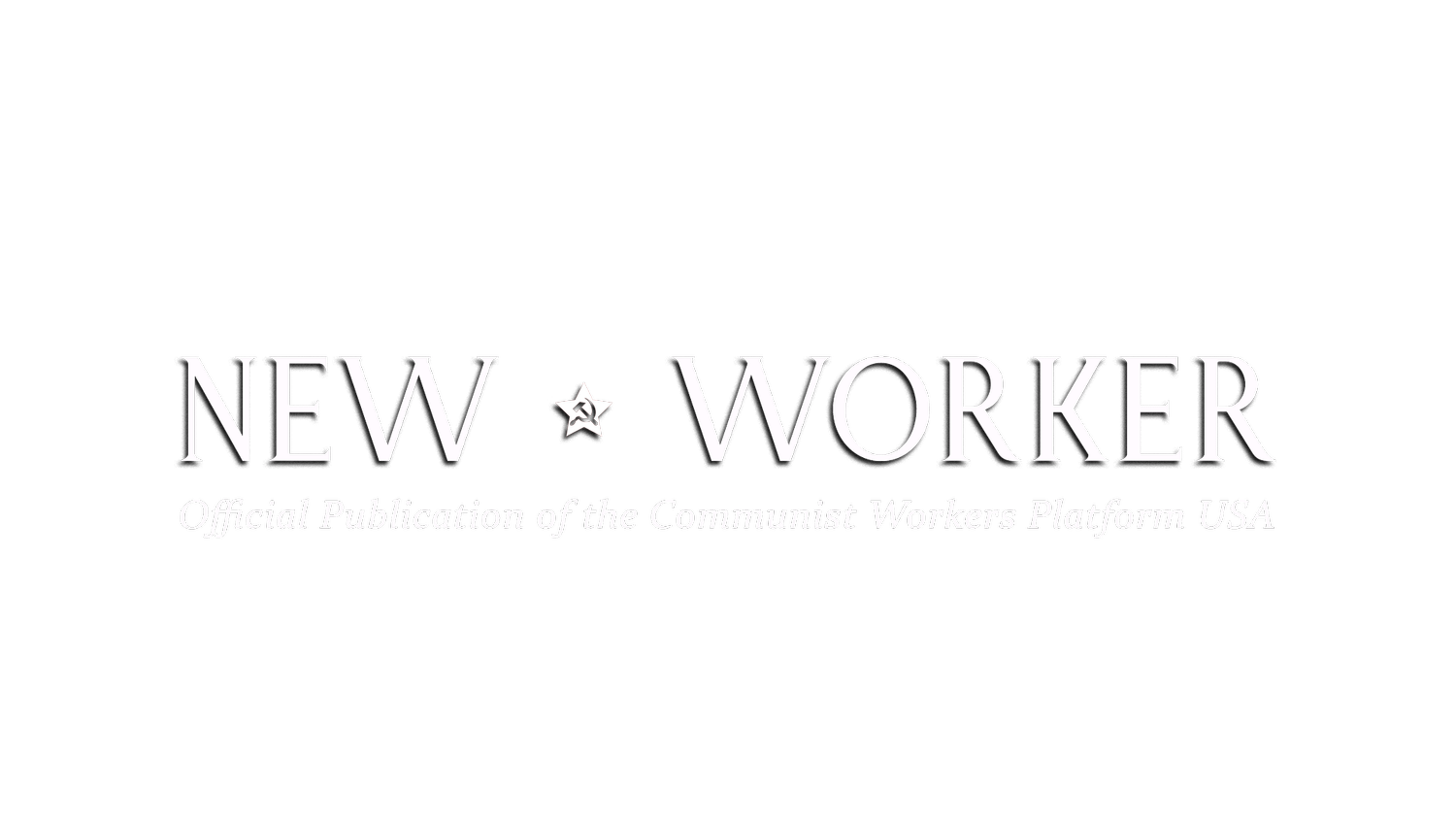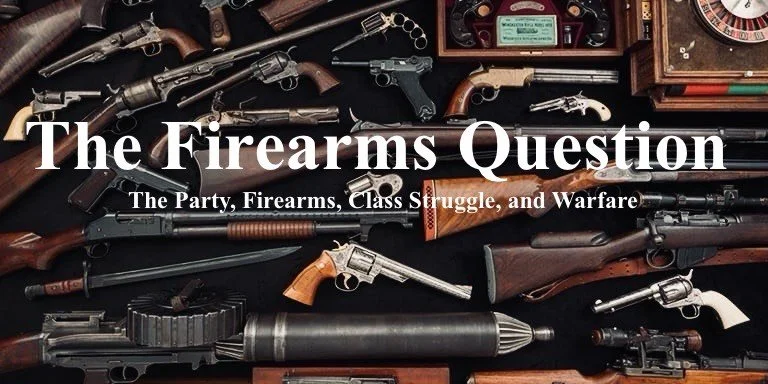Part 1: Firearms, Warfare, and the International Communist Movement
Authors Note
Written in the summer of 2025, this analysis opens a series for New Worker examining what we might call the firearm question: the historical, political, and theoretical role of arms within revolutionary struggle.
The anti-racist uprisings five years ago reshaped the firearms industry, the state’s approach to “security,” and the political atmosphere of demonstrations. These shifts coincided with an escalation of repression: the Trump administration’s nationalization of police forces, the expansion of ICE, and the increased domestic deployment of the National Guard. As these state formations grow more militarized, so too does the question of how revolutionaries understand firearms, not as consumer products or cultural symbols, but, as instruments of class power.
Understanding the firearm under capitalism and under socialism requires revisiting a long history: how Communists have theorized and organized armed struggle, how revolutions have been defended, and how these experiences inform our present.
Firearms and Class Power
The Communist movement has never been unfamiliar with firearms. Any movement that aims to seize and hold political power must confront the reality that class supremacy depends on superior organization, technology, and the strategic use of force.
The bourgeoisie maintains its dominance through millions of armed personnel — police, private security, and standing armies — deployed not chaotically but in disciplined defense of property and profit. Disorganization leaves the proletariat powerless. The firearm, therefore, is not merely a weapon but a force multiplier, an expression of whether a class possesses the organization necessary to defend its interests. History repeatedly demonstrates that only an organized proletariat can challenge bourgeois rule.
Necessity of an Armed Proletariat
In 1850, Marx and Engels addressed the Communist League:
“To be able forcefully and threateningly to oppose this party, whose betrayal of the workers will begin with the very first hour of victory, the workers must be armed and organized. The whole proletariat must be armed at once with muskets, rifles, cannon, and ammunition, and the revival of the old-style citizens’ militia, directed against the workers, must be opposed. Where the formation of this militia cannot be prevented, the workers must try to organize themselves independently as a proletarian guard, with elected leaders and with their own elected general staff; they must try to place themselves not under the orders of the state authority but of the revolutionary local councils set up by the workers. Where the workers are employed by the state, they must arm and organize themselves into special corps with elected leaders, or as a part of the proletarian guard. Under no pretext should arms and ammunition be surrendered; any attempt to disarm the workers must be frustrated, by force if necessary. The destruction of the bourgeois democrats’ influence over the workers, and the enforcement of conditions which will compromise the rule of bourgeois democracy, which is for the moment inevitable, and make it as difficult as possible – these are the main points which the proletariat and therefore the League must keep in mind during and after the approaching uprising.“ (1)
Through a sober analysis of their conditions, they warned that the petty bourgeoisie would betray the workers at the first sign of victory, and concluded that the proletariat must be “armed and organized.” They urged workers to form their own militias, select their own leadership, and resist any attempt at disarmament by the state.
It’s easy to impress by quoting Marx and Engels, but true radicalism is proven only in practice. Poor steel shatters in the forge, just as those who don’t grasp the gravity of their words eventually do when tested by reality. Marx and Engels recognized that, following this revolutionary turning point, the proletariat could only secure its position by smashing the bourgeois state, and move toward the abolition of all class distinctions, by taking up arms. Though their call went unrealized at the time, the Paris Commune, two decades later, would confirm the firearm as an indispensable tool in the struggle for socialism-communism.
From Marx to Lenin
By the early 20th century, these ideas were further developed within the Russian Social Democratic Labor Party (RSDLP). Its 1903 program called for the “replacement of the standing army by the universal arming of the people: “Replacement of the standing army by universal arming of the people.” (2)
Again, context is important here, as this is referring to the defense of the socialist revolution, the establishment of the transitional state. The Bolsheviks would not wait for socialism to make this a reality. In 1905, with the resolution On Armed Uprising, they established the Voyenki, the Bolshevik Combat Organizations, or Red Guards (most commonly discussed amongst circles in the US), guided by Lenin’s directive to “establish combat squads everywhere... and let them arm themselves immediately, as best they can.” Drawing heavily from Sovikin’s Bolshevik Military and Combat Organizations, these groups, initially formed to resist the reactionary Black Hundreds, and became the embryo of revolutionary military organization.
In the early process of their establishment, Lenin wrote:
“Immediately establish combat squads everywhere and anywhere, both among students and especially among workers, etc., etc. Let detachments of 3 to 10, 30, etc. people be organized immediately. Let them arm themselves immediately, as best they can... Let these detachments immediately choose their own leaders and, if possible, contact the Combat Committee of the St. Petersburg Committee” (3). (Poln. sobr. soch., 5th ed., v. 11, pp. 336-37).
By 1906, these combat groups were formally subordinated to Party leadership, forming the basis of a disciplined structure capable of coordinated political and military activity. While work was redirected in 1907, this did not lead to their dissolution, and even when the RSDLP as an organization moved away from its most illegal activities, such as armed skirmishes against the state, expropriation, etc, these organizations remained. When the First World War erupted, these organizations printed multiple papers for distribution and intensified training and political work among soldiers, preparing the ground for 1917. This preparation would prove decisive in overthrowing the Kerensky government and defeating the Russian bourgeoisie.
This experience would be taken into account, as Lenin had already called for the “abolition of the police, the army, and the bureaucracy” in the April Thesis (4), and reiterated proposed changes to the party program:
“The experience of the Russian revolutions of 1905 and 1917, which created the Soviets of Workers’ Deputies and a number of similar organisations, thereby confirmed the experience of the Paris Commune, which consisted in the fact that the proletariat must have a state for the period of transition to socialism, but this state{2} must not be a conventional type of state, but the immediate, massive and wholesale organisation of the armed workers to substitute for the old instruments of administration: the standing army, the police and the civil service.“ (5)
The Standing Army Under Socialism
Following the October Revolution of 1917, the Bolsheviks reorganized the combat organizations into the Soviet Armed Forces in 1918, marking the foundation of the Red Army. This has raised a long-debated question: if socialism seeks the abolition of the standing army, why did the Soviet Union maintain one? Such a question is often raised with the objective of slandering the Bolsheviks, the Soviet Union, and the International Communist Movement.
The formation of the standing army under the workers’ state, following the socialist revolution, is the product of the Bolsheviks very carefully analyzing revolutionary history, the conditions they were operating under, and putting front and center the aims of establishing a revolutionary society. The new Soviet state faced a devastating civil war and direct invasions by multiple foreign powers. The bourgeoisie internationally desired the destruction of the new socialist state. The failure of the German Revolution marked a halt in the move of socialism westward. World War I would introduce a new kind of mechanized warfare - tanks and aircrafts - demanding an equal response.
The Soviet Union therefore had to maintain an army capable of repelling invasions and operating specialized equipment within coordinated plans of attack. That practical necessity does not negate the goal of moving beyond a standing army; it simply requires a material, realistic approach. The existing army, police, and other instruments of the bourgeois state needed to be dealt with, and the socialist state, in turn, must establish its own organs to defend itself and administer society. Any institutions the socialist state creates should exist only as long as necessary and be dissolved when feasible.
In The Armed Forces and Revolution, Lenin wrote:
“Everywhere, in all countries, the standing army is used not so much against the external enemy as against the internal enemy. Everywhere the standing army has become the weapon of reaction, the servant of capital in its struggle against labour, the executioner of the people’s liberty.“ (6)
Nearly 90 years later, this observation takes on a fascinating character; the 1991 counterrevolution in the Soviet Union demonstrates just what kind of internal enemies can exist. These experiences must guide our revolutionary course, for we can be sure that when the manor is seized, something will always crawl out of the woodwork to reclaim it.
The Revolutions of the 20th Century
The International Communist Movement, of course, was adaptable. Many other socialist revolutions of the 20th century would see, not formal standing armies going head-to-head, but guerrilla armies of volunteers and dedicated revolutionaries trained in Marxism-Leninism, such as in Cuba and Vietnam.
On Guerrilla Warfare by Mao Zedong is often assigned reading for armies all over, including the U.S. military across various units in various branches. Che Guevara would also make his contribution with Guerrilla Warfare. We can even see the Angolan Civil War as evidence of how we should be flexible in how we conduct warfare, as Soviet advisors struggled in the wake of the opposing South African incursion , where Fidel Castro and Cuban units were able to better advise and collaborate with MPLA units, and successfully suppressed enemy forces. Despite the Cuban Revolutionary Armed Forces (FAR) being a formal standing military, the product of fusing Cuban revolutionary forces and personnel of the former army of the Batista regime, Cuba’s military hardware, professional forces, and experienced guerrilla fighters allowed Cuban forces to aid in both conventional and Guerrilla warfare.
Conclusion
Returning to our present, the question of arms once again looms. The US state has concentrated force through militarized police, border patrols, and domestic deployments of the National Guard and federal agents. The firearms industry profits from crisis while shaping the culture of violence that sustains capitalism. The question cannot be reduced to personal gun ownership or legal debates. It is a question of its connection to class society, power, organization, and political clarity. To build a force capable of seizing power and defending itself once it has won we must understand how every past revolution confronted the same contradictions.
This leads us to three questions that guide the continuation of this series:
If standing armies have become a necessity under certain conditions, what makes them ultimately incompatible with socialism-communism?
If the state is under proletarian control, why does an army of that same proletariat appear contradictory to socialism’s long-term aims?
And finally, why do we have standing armies?
To adequately answer these, we will need to observe capitalism’s development. These are not abstract inquiries. They determine whether the working class will remain subject to the armed power of capital or become its own organized force.

